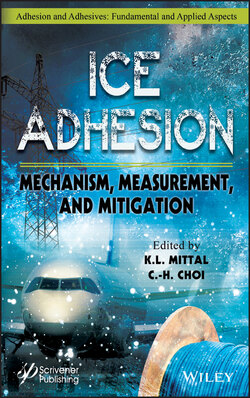Читать книгу Ice Adhesion - Группа авторов - Страница 22
1.3.2 Wetting of Real Surfaces
ОглавлениеA chemically homogeneous, inert, perfectly flat, and completely rigid surface, like the one considered by Young, is never encountered in the real world. In reality, a liquid in contact with a solid surface will yield contact angles over a range of values while the triple-phase contact line remains pinned due to chemical heterogeneities and surface roughness. This range of contact angles is bracketed by the receding contact angle, θ , at the minimum and the advancing contact angle, θA –θR, at the maximum.R Solid-liquid contact angle hysteresis is equal to θA – θR and demonstrates how well the contact line is pinned [104]. Rare, too, is a surface which is wetted by water in a pure Cassie-Baxter state under all conditions. Depending on the temperature and pressure of the system, water can infiltrate the air pockets, leading to a partial penetration, or a full Cassie-to-Wenzel transition. As will be shown, the loss of a pure Cassie-Baxter wetting state has consequences with regards to ice adhesion.
Consider a water droplet sitting on a highly roughened surface, such as the square-pillared example given in Figure 1.8(a). Two competing pressures are acting on the solid-air-liquid system. The balance of the wetting and anti-wetting pressures determines the degree to which the liquid will penetrate into the microstructure. The wetting pressure arises from: (1) the hydrostatic pressure of the water column above each pillar unit, (2) the Laplace pressure from the curved air-liquid interface, and, if applicable (3) the dynamic pressure from the kinetic and shock-wave energy of an impacting water droplet [105]. The wetting pressure of the droplet is countered by the anti-wetting pressure of the surface. This pressure arises from the force caused directly by the surface tension of the liquid, Fγ, per unit area of surface which comes into contact with the water. The surface tension of water-air, γWA, acting through the length of the triple-phase line, L (i.e. the perimeter of the square pillars, as shown in Figure 1.8(b)) gives rise to Fγ [106].
Figure 1.8 (a) The degree to which water will penetrate into the pores of a highly roughened surface is a result of a balance between wetting and anti-wetting pressures, (b) The anti-wetting pressure arises from the vertical component of the water-air surface tension, γWA, acting through the length of the triple-phase contact line.
(1.40)
Of course what concerns us when discussing the degree to which water will penetrate into pores is the vertical component of the surface tension force, given by Equation 1.41
(1.41)
where α, the slope of the capillary force, is the intrinsic water contact angle minus π/2, as shown in Figure 1.8(b).
It is clear from the wetting/anti-wetting pressure balance that the surface tension of water, γWA, and the intrinsic water contact angle, θY, have great influence over whether partial penetration into surface features will occur. The surface tension of water increases with decreasing temperature [107]. In light of this trend, one would expect the partial penetration of water into surface asperities to lessen with decreased temperatures, as Fγ becomes larger. However, experimental results have shown that the opposite is in fact true when surface temperatures approach the dew point [80, 108, 109]. The reason being that at or below the dew point temperature, water molecules will adsorb on the cold surface. Adsorption will occur regardless of whether the said surface is intrinsically hydrophobic or hydrophilic [110–112]. As shown in Figure 1.9(a), the adsorption of water molecules results in the solid-air surface free energy, γSA, becoming equal to the surface tension of water, γWA [113, 114]. Thus, the adsorbed water molecules effectively render the solid surface hydrophilic, presenting a low intrinsic water contact angle, θY.
The pressure balance of a surface with micro- and nanoscale roughness, such as the square pillar example of Figure 1.8, is now altered with decreasing temperature. Particularly, the vertical component of the surface tension force (and thus, the anti-wetting pressure) will decrease as the dew point temperature is crossed, with θY decreasing. The effect of temperature on the intrinsic water contact angle of PDMS is shown in Figure 1.9(b). As the surface temperature is decreased from 20°C to 2°C, the intrinsic contact angle is decreased from 114° to 94° [109]. An example of how water molecule adsorption with decreased surface temperature affects water penetration depth is given in Figure 1.9(c). Ling et al. (2016) report that the depth of water penetration into their copper square pillar surface increases from 4.9 μm (5.2% of the pillar height) at room temperature to 64.6 μm (69% of the pillar height) at 0°C [108].
Figure 1.9 (a) The pore walls of a superhydrophobic substrate become intrinsically hydrophilic with decreasing surface temperature due to water molecule adsorption. This change in the intrinsic water contact angle of the pore leads to lessened capillary pressure and a Cassie-to-Wenzel transition, (b) The effect of surface temperature on the intrinsic water contact angle of poly(dimethylsiloxane) (PDMS). Adapted from [109]. (c) The change in water penetration depth, c, with a change in temperature on copper square-pillared substrates. Adapted from [108]
